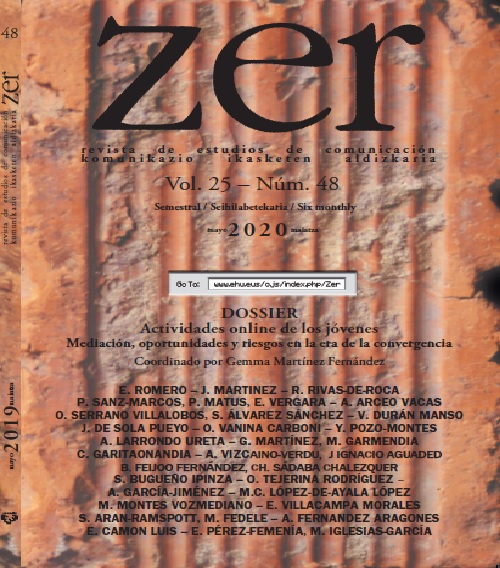Espainian 2015eko eta 2016ko hauteskunde orokorretako hauteskunde eztabaidetarako erreferentzia esparruak: hautagaien sinesgarritasuna gazteen artean
##plugins.themes.bootstrap3.article.main##
##plugins.themes.bootstrap3.article.sidebar##
Olga Serrano Villalobos
Sergio Álvarez Sánchez
Laburpena
Lan honek hauteskundeetarako hautagaien komunikazio esparruen eragina deskribatzen du boto emaile gazteek esleitu zieten sinesgarritasunean, eta horrek 2015eko eta 2016ko hauteskunde orokorretarako bi eztabaidetan izan zuen eragina. Inkestak gainbegiratu ziren, publizitate politikoaren eta eztabaiden euren deskripzio azterketak eginez. Antzemandako sinesgarritasuna aztertzeko, bi eztabaida talde antolatu ziren jardule gazteekin. Azkenik, edukien azterlanak egin ziren hautagaien txioei buruz. Gatazka esparruek nekatu egin zituzten boto emaileak, nahiz eta Mariano Rajoy izan zen sinesgarriena gazteen artean, haren naturaltasunagatik.
Nola aipatu
##plugins.themes.bootstrap3.article.details##
Komunikazio politikoa, sinesgarritasuna, hauteskunde kanpainak, hautagaiak, hauteskundeak, eduki analisia.
Arceo, J. L. (1993). Campañas para elecciones generales: introducción. In J. L. Arceo (dir.), Campañas electorales y "publicidad política" en España (1976-1991) (pp. 17-21). Barcelona: Escuela Superior de Relaciones Públicas.
Berelson, B. (1952). Content analysis in communication research. Michigan: Free Press.
Berganza, M. R. (2008). Medios de comunicación, "espiral del cinismo" y desconfianza política. Estudio de caso de la cobertura mediática de los comicios electorales europeos. ZER Revista de Estudios de Comunicación, 13(25), 13-30. Recuperado de https://www.ehu.eus/ojs/index.php/Zer/article/view/3580/3208
Berrocal, S., Redondo, M., Martín, V., & Campos, E. (2014). La presencia del infoentretenimiento en los canales generalistas de la TDT española. Revista Latina de Comunicación Social, 69, 85-103. doi: 10.4185/RLCS-2014-1002
Brüggemann, M. (2014). Between frame setting and frame sending: how journalists contribute to news frames. Annals of the International Communication Association, 27(1), 293-335. doi: 10.1111/comt.12027
Cappella, J. N., &Jamieson, K. H. (1996). News frames, political cynicism, and media cynicism. The ANNALS of the American Academy of Political and Social Science, 546(1), 71-84. doi: 10.1177/0002716296546001007
Cappella, J. N., & Jamieson, K. H. (1997). Spiral of cynicism: the press and the public good. New York: Oxford University Press.
Chadwick, A., O'Loughlin, B., & Vaccari, C. (2017). Why people dual screen political debates and why it matters for democratic engagement. Journal of Broadcasting & Electronic Media, 61(2), 220-239. doi: 10.1080/08838151.2017.1309415
Chaiken, S., & Maheswaran, D. (1994). Heuristic processing can bias systematic processing: effects of source credibility, argument ambiguity, and task importance on attitude judgment. Journal of Personality and Social Psychology, 66(3), 460-473. doi: 10.1037/0022-3514.66.3.460
Coleman, S., & Moss, G. (2016). Rethinking election debates: what citizens are entitled to expect. The International Journal of Press/Politics, 21(1), 3-24. doi: 10.1177/1940161215609732
Druckman, J. N. (2001). On the limits of framing effects: who can frame? The Journal of Politics, 63(4), 1041-1066. doi: 10.1111/0022-3816.00100
Entman, R. M. (1993). Framing: toward clarification of a fractured paradigm. Journal of Communication, 43(4), 51-58. doi: 10.1111/j.1460-2466.1993.tb01304.x
Goffman, E. (1974). Frame analysis: an essay on the organization of experience. Cambridge, MA: Harvard University Press.
Hovland, C. I., Janis, I. L., & Kelley, H. H. (1953). Communication and persuasión: psychological studies of opinion change. New Haven, CT: Yale University Press.
Hovland, C. I., & Weiss, W. (1951). The influence of source credibility on communication effectiveness. Public Opinion Quarterly, 15(4), 635-650. doi: 10.1086/266350
Iyengar, S. (1991). Is anyone responsible? How television frames political issues. Chicago: University of Chicago Press.
Johnston, J. (2017). The public interest: a new way of thinking for public relations? Public Relations Enquiry, 6(1), 5-22. doi: 10.1177/2046147X16644006
L'Etang, J. (2008). Public relations: concepts, practice and critique. Londres: Sage.
Mazzoleni, G. (1998). La comunicazione politica. Bologne: Il Mulino.
Metzger, M. J., Flanagin, A. J., Eyal, K., Lemus, D. R., & McCann, R. M. (2003). Credibility for the 21st century: integrating perspectives on source, message, and media credibility in the contemporary media environment. Annals of the International Communication Association, 27(1), 293-335. doi: 10.1080/23808985.2003.11679029
Ohanian, R. (1990). Construction and validation of a scale to measure celebrity endorsers' perceived expertise, trustworthiness, and attractiveness. Journal of Advertising, 19(3), 39–52. doi: 10.1080/00913367.1990.10673191
O'Keefe, D. J. (1990). Persuasion: theory and research. Newbury Park, CA: Sage.
Pan, Z., & Kosicki, G.M. (2001). Framing as a strategic action in public deliberation. In S. D. Reese, O. H. Gandy & A. E. Grant (eds.), Framing public life: perspectives on media and our understanding of the social world (pp. 35-66). Mahwah, NJ: Lawrence Erlbaum.
Semetko, H. A., & Valkenburg, P. M. (2000). Framing European politics: a content analysis of press and television news. Journal of Communication, 50(2), 93-109. doi: 10.1111/j.1460-2466.2000.tb02843.x
Strömback, J., & Kiousis, S. (2011). Political public relations: defining and mapping an emergent field. In J. Strömback, & S. Kiousis (eds.), Political Public Relations. Principles and Applications (pp. 1-32). New York and London: Routledge.
Taylor, M. (2010). Public relations in the enactment of civil society. n R. Heath (ed.), The Sage handbook of public relations (pp. 5-16). Thousand Oaks, CA: Sage.
Vaccari, C., Chadwick, A., & O'Loughlin, B. (2015). Dual screening the political: media events, social media, and citizen engagement. Journal of Communication, 65(6), 1041-1061. doi: 10.1111/jcom.12187
Yanes, R. (2006). Límites éticos del mensaje persuasivo en la comunicación política. ZER Revista de Estudios de Comunicación, 11(20), 57-69. Recuperado de https://www.ehu.eus/ojs/index.php/Zer/article/view/3746/3376

This work is licensed under a Creative Commons Attribution-NonCommercial-NoDerivatives 4.0 International License.
(c) UPV/EHU Press


 http://orcid.org/0000-0002-5981-4397
http://orcid.org/0000-0002-5981-4397